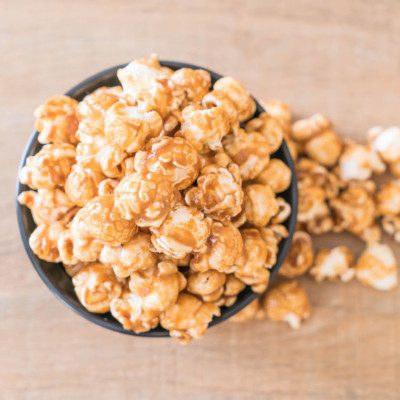How does caramelization work?
Caramelization is a poorly understood series of pyrolysis reactions that occur in carbohydrates when exposed to high temperatures. Most sugars can caramelize and the temperature necessary for caramelization varies with the type of sugars. Fructose, for example, requires an initial temperature of 150oC while maltose caramelizes at 180oC.
The mechanism of caramelization development involves many steps starting with carbohydrates (reducing mono- and di-saccharides) decomposition, dehydration and degradation, followed by the formation of small molecules, a lag phase and eventual condensation or polymerization to form complex molecules of varying molecular weights.3 The exact type of products formed is dependent on the sugar chemistry as well as process conditions such as temperature, pH, water activity among others. Caramelization of sucrose, for example, can be divided into the following stages:
- First stage – thermal decomposition and fragmentation to yield glucose and fructose. These sugars can individually lose water and react with each other.
- Second stage – isomerization of fragmented sugars (aldoses to ketoses) and further elimination of water to form the sugars’ anhydro forms.
- Third stage – additional fragmentation, polymerization and subsequent formation of volatile flavor compounds such as furan, maltol, ethyl acetate, diacetyl, etc. as well as brown colored compounds such as caramelan, caramelen and caramelin.
To impart desirable colors and flavors in bakery products, the caramelization process should be allowed to take place under controlled conditions to avoid the generation of excessively dark colors and bitter flavor compounds. Progress of caramelization reactions is monitored visually as well as analytically using various techniques such as:
- UV-visible absorbance measurements (UV-vis)
- High performance liquid chromatography (HPLC)
- Gas chromatography (GC)
Application
Caramelization can occur in many systems other than baked products. Depending on the time and temperature, a wide range of colors can be generated from yellow and brown shades. Similarly, flavors obtained from caramelization reactions can vary from mild sweet caramelized to bitter and burning.
In addition to colors and flavors, changes in the sugar structure and the loss of water during caramelization can have a significant impact on the mechanical and barrier properties of carbohydrate-containing baked system.
Caramel can be used as a filling, topping, or as a glaze. Flan and custard cake varieties commonly have a thin glaze of caramel drizzled topically. Hardened caramel can also be used in decorating applications because of the molding properties before complete hardening.
Special considerations
- Residual sugars, i.e., fermentable and non-fermentable sugars can enhance the caramelization process and the generation of browning in baked goods. Caramelization reaction rates can be modulated by changing the medium’s pH range. For example, at pH 7, caramelization reaction rates are the slowest while they are fastest at acidic pH’s.
- Monosaccharides brown or caramelize faster than most disaccharides. Invert syrup, which contains the monosaccharides fructose and glucose, browns faster than sucrose.
- Bakery products formulated with honey or high fructose syrup generate more intense caramelization. In baking applications, the rate of caramelization from fastest to slowest, is as follows: Fructose > glucose > lactose > maltose > sucrose > isomalt.4
References
- Gisslen, W. “Basic Baking Principles” Professional Baking, 7th edition, John Wiley & Sons, Inc., Hoboken, New Jersey, 2017, pp. 93–101.
- Valdés Martínez, S.E. “Hidratos de Carbono” Química de los Alimentos, 4ta edición, Pearson Educación de México, S.A. de C.V., 2006, pp. 29–108.
- Kroh, L.W. Caramelization in foods and beverages. Food Chem. 1994, 51, 4, pp. 373-379.
- Figoni, P. “Sugar and Other Sweeteners” How Baking Works: Exploring the Fundamentals of Baking Science, 3rd edition, John Wiley & Sons, Inc., Hoboken, New Jersey, 2011, pp. 164–190.

